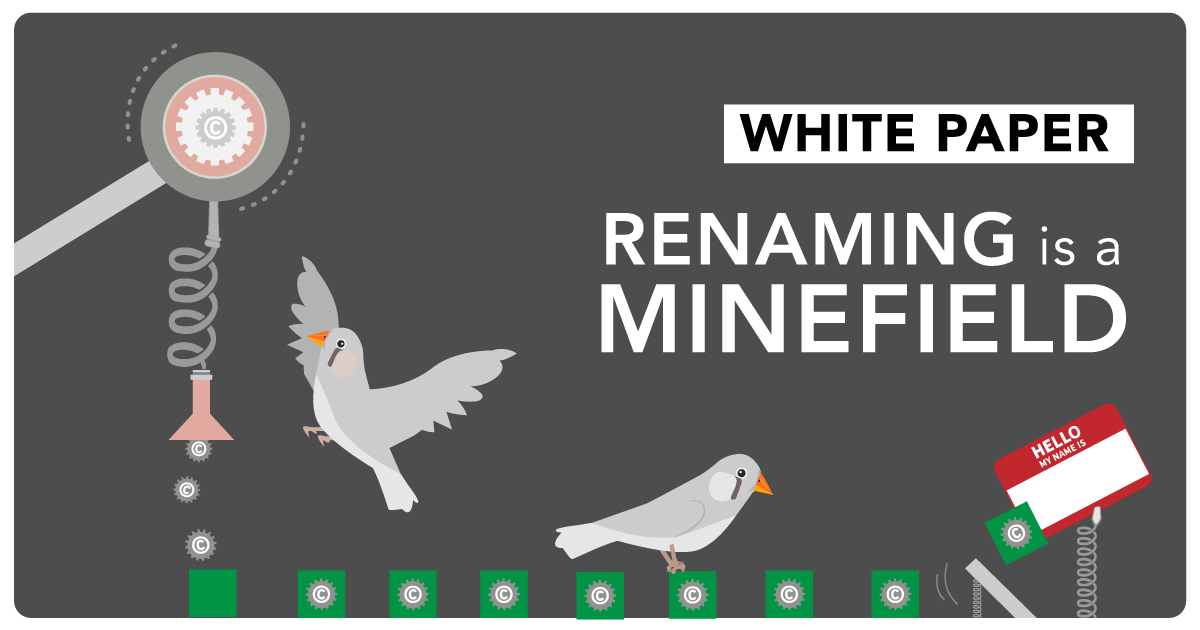Renaming is a Minefield

Naming is an art, an extreme test of creativity and, when done right, results in a bouncing baby brand. You get visibility, findability, differentiation, and relevance.
A unique powerful name should evoke an appropriate emotional response in the target market: hipness or gravitas or whimsy or dignity or aspiration. It’s the beginning of a compelling brand narrative. But when naming is done badly? Well, read our White Paper on the dreaded three-initial company name.
Naming may be fun, but renaming?
That’s a horse of a different kettle of fish in a nutshell. As they say.
The gathering hazard: the existing name has become inappropriate or faded or failing, and these judgments put storm clouds on the horizon because they are subjective. Second, there are always timid people who believe names shouldn’t change, which adds rumblings of thunder to the clouds. Third, there are fears of losing brand equity/visibility/reputation/whatever if the transition is badly handled. Monsoon.
The renaming process can never be free of risk or conflict since the cost-to-benefit ratio is often a legitimate concern. Will you lose customers? Brand equity? Trust? Credibility? Or just the cost of printing new business cards and a lobby sign? Will the new name communicate growth, weakness, opportunity, panic, power, instability, confidence?
Before you take the plunge, chew on these:
1. Do your homework. What do your stakeholders (outside and inside) believe and perceive now? Some answers can come from research, such as how much equity is in your current identity. Some answers can only come from within, such as should we invest in and trust research? What’s our tolerance for risk? What’s cast in concrete? If the CEO is in love with the logo, or hates the color blue, or another future complication, know that up front.
2. If you’re legally obliged to change, start without delay. The IP lawyers from that other company will not be patient.
3. If you’re not legally obliged to change, start without delay. Why procrastinate? Set a schedule and a budget, then start the ignition.
4. Evolution, not revolution. People hate sudden drastic changes. Make sure you do your spadework first, telling them what’s going to happen. Then tell them it’s happening. Then tell them it happened. Employees first, customers/distributors second, prospects next, the general public eventually. Be aware that almost always, name changes occur in stages. The fear of confusing or losing customers is legitimate. But that fear can be minimized using best practices in the transition. There are penalties for moving too quickly or too slowly. We can advise you on all those thorny issues because we’ve seen them all before.
5. Consider the gestalt of your brand, not just the name alone. Is your tagline up to date and powerful? Your mission? Your story? If it’s really a fresh start, don’t slap a coat of paint over rotten boards. Rethink logo, tagline, website, brand story, marcomm, packaging and labeling, signage, all facets of corporate identity. Are you adhering to – or breaking from – tradition? Will the design sensibility of your new identity speak of sophistication or stability? Cutting edge, or comfort? (Hint: if your new name has “solutions” in it, the tagline contains “artisanal,” or the logo has an orbit around it, people will snicker. We’re just sayin’.)
6. Make sure you won’t have to do it again soon. Did you outgrow your name? Could that happen again next year? Will the new name account for future acquisitions or redirection?
7. Are you supporting multiple brands? Should they be tied together, or kept apart? Can you afford to maintain multiple identities? How many?
8. Focus on your prospects. Current customers, distributors, vendors and partners are a finite audience, and you should talk to them clearly, directly, and often. Company insiders are easily found and can be convinced. But prospects, your not-yet-customers, are the big lever to geometric growth. Value their perceptions above every other audience.
9. Pay close attention to SEO and social media. SEO for the findability needed to get your new name in front of prospects, social media to make sure that the increased visibility is adding to and improving your reputation. Reputation management is a crucial component of a successful renaming. Don’t be satisfied with good awareness numbers. The game is not over if people know you but don’t care.
10. Final approval should come from the CEO, not a committee. Committees have a lousy track record for writing symphonies, painting paintings, and naming companies. Likewise crowdsourcing, aka crapsifting. The let’s-have-a-contest-among-employees impulse when renaming has a 100% track record of hard feelings, division and ill-fated ugly results.
Last but not least: Outsource the process.
Company naming is not your basic business, not your core competency. Our branding agency brings valuable objectivity, and more experience with processes, budgets, timetables, trademark laws, design and other minefields. Of course, it doesn’t have to be us, but (no offense) it shouldn’t be you.